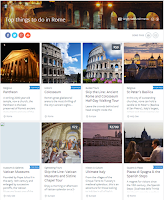We now come to the raison d'etre for this entire exercise - seeking wonderful and exhilarating experiences. Some may want to jump off a cliff to experience that rush, while other may experience that rush, standing in silence, in front of a painting.
The Local Itinerary
Your local itinerary decides what you see, and what you decide to skip, hopefully to see when you return another day. The level of control you wish to exercise and the flexibility you want in your daily movements will determine the kind of itinerary you create. This may range from a detailed minute by minute plan for each day to a rough list of places you would like to visit every day. I started with the former 'control freak' version and ended up following the latter 'free spirit' version during the holiday.
Step By Step Guide to Itinerary Preparation
So here are the steps to prepare your local sightseeing plan.
Step 1 - What are the sights you want to visit? You may already have a rough idea of what you would like to see based on your initial research on how many days to spend in each city. You now make the full list of must see and like to see places.
Step 2 - Check which days they are open and their timings. This is extremely important. You dont want to travel a 1000 miles to a city with a plan of seeing one all important museum - and realising it is closed on that day. You can also note its entry fees, for deciding whether to buy a pass or not.
Step 3 - Decide how much time you would like to spend at each place. this is an individual choice. You may be satisfied with just walking into the Louvre, see the Mona Lisa and walk out. Or you may want to spend two full days exploring this awesome museum. Please include the waiting time for entering the place in your calculations. You may have to stand in line for hours in the more popular attractions in Europe. So, check the recommended days or times of entry to avoid waiting too long. For example, you can save over an hour of standing in line by going to the Louvre on a thursday evening, when it is open till 8 PM.
Step 4 - How are they located with respect to each other? In some cities, all the major sights are within walking distance of each other, while in some, most are hours apart. Examine their location on a map and decide which are close enough to be done together.
Step 5 - Prepare the Daily Plan. :-)
Online Resources
There is no single website which helps you in all these steps. Depending upon the level of detail you prefer, a combination of the following resources should help you in making your itinerary.
Attraction Finders. The following websites will help you decide what to see or do, giving further details of the attraction, including its timing and website. You can also read the users reviews for useful information.
- Tripadvisor - Select the City and choose "Things to Do". It gives you a list, including places to see and activities to do, ranked by visitors, with community reviews. You can further view them by category, such as landmarks, museums, outdoor activities, tours, food and drinks, etc. This list is an exhaustive one, generally covering even the minor and innocuous places. For example, Rome shows 985 things to do. So choose the activity you are interested in, for example Sights and Landmarks, and look at the top 10. That should give you more than enough things to do. Recommended.
- Lonely Planet - The web version of the old faithful. I wasn't quite happy with this offering of the venerable Lonely Planet, the print version of which I have used for numerous trips, the book always providing accurate and great advice. This site has too many plugs for private tours between the results you are searching for. They have probably given up on this site and started concentrating on their new offering, TouristEye.
- TouristEye - This is a new website and mobile application by Lonely Planet. An excellent website to help you decide. It has a neat tiled layout, making it easy to get an overview of the major attractions. Their list includes the best 'experiences', 'attractions' and 'eating places' the destination has to offer. The site also has a nice Map layout which shows all the attractions on google map. Highly recommended.
- TimeOut - If the city you are visiting has a TimeOut edition. This is a great site to check out events and activities happening in the city during your stay.
- VirtualTourist - It is a free website providing travel guides to locations around the world, written by ordinary users and tourists. Very comprehensive.
- And of course Google - Search for 'Top 10 things to see or do' for the city. It will give you an overdose of results, ranging from commercial websites to user blogs. In addition, a search for most major destinations, google will display a list of top attractions in that city on top of the search results. Lists provided by The Telegraph, Huffington Post and Guardian are generally excellent.
Online Planners. The following websites more than just help you decide what to see - they actually make an itinerary for you.
- VisitaCity - Select your destination and how many days you are spending there, and then choose your travel guide from the choices, ranging from easy going, kid-friendly, must see, etc. You can see the planned itinerary on a map, including distance between them, travel time and how much time to spend in each place. You can further modify the plan to your liking, and then you can download a PDF copy of your itinerary, including the route map. Highly recommended.
- Planapple - A similar website for creating your itinerary. Not as polished as VisitaCity, but gives you more control over the plan.
Ready Made Itineraries. And finally there are the ready made, ready to use itineraries. Excellent, tried and tested routes with minimal effort. Just search on Google with phrases like "Itinerary for Rome in 3 days" or "suggested itinerary for.....". The search results include offerings by travel websites and bloggers. Some offerings, like those by Frommers, Reids, etc include travel directions, such as which bus or tram to take to go from one place to another.

The Final Outcome
The final outcome of all this research should be a document, maybe paper or electronic, which helps you in planning your day. Everyday when you get up and go out, you should have an idea about what you wish to do, so that you do not waste time wandering around, deciding what to do. Please remember, wandering around without purpose is not a bad idea by itself. It is the wandering, when you can't decide where to go, which leads to waste of time and increasing frustration, spoiling the holiday. In my opinion, a document with dates, giving the intended places of visit, separately for the forenoon and afternoon of each day, is the minimum you should aim for.
Here are a few example.
I saved my entire plan as a calendar on Google Calendar. It is convenient and permits you to access it from any place or device. I would highly recommend this.
Additional Tip
Where to Eat. You can also use Google to find out the best places to eat in each city. Use search phrases like "cheap places to eat in ....", "best budget places to eat in ....", "top budget eateries in...", "eat like a local in .....", etc. Websites like The Telegraph, Huffington Post, Guardian, SeriousEats, etc have some excellent articles. When you get the results, just look up their location. Based on their location, and your plan for each day, you can decide where to eat your meals everyday. This can save you time and money, while giving you a taste of the culinary variety of the places you visit.
For those days when you just want plain, cheap calories, lookup the location of the nearest McDonalds, KFC, etc. They are generally located near most famous landmarks, prominently displaying their logos, inviting hungry tourists into their lairs.
Insider Secrets. Another extremely useful google search to do before you finalise your plan is "insider secrets of .....", "save money when in ....", "visiting ..... on a budget", etc. This can give you links to great articles. Apart from those already mentioned, these websites are also useful - eurocheapo, budgettravel, cntraveler, budgettraveller. They can give you fantastic tips on how to avoid long queues, get cheap entry tickets, etc.
Insider Secrets. Another extremely useful google search to do before you finalise your plan is "insider secrets of .....", "save money when in ....", "visiting ..... on a budget", etc. This can give you links to great articles. Apart from those already mentioned, these websites are also useful - eurocheapo, budgettravel, cntraveler, budgettraveller. They can give you fantastic tips on how to avoid long queues, get cheap entry tickets, etc.
Conclusion
In conclusion, the Internet is a cornucopia of information. You can get lost, doing hours and hours of 'research', among the thousands of websites. Please remember, you are not planning a military campaign, you are trying to ensure that your fun trip remains fun. The aim of all this research is to ensure that you do not encounter any hiccups which ruin your holiday.
The level and type of planning required for a young student is very different from that for a family with a young kid. Planning for meals, toilet breaks, rest breaks, kids entertainment, etc are extremely important aspects for a family, while all the student really needs to know is where to find budget accommodation, good food and good company. So decide on your comfort level, balancing details and flexibility, and go ahead.
In the next post, we look at getting around within a city and the worth and utility of passes.
**********************************************************************************
Other posts in this series......
Eurotrip 2015 - Our Grand Tour
Eurotrip 2015 Episode 1- Genesis
Plan a European Holiday in 5 Easy Steps
How to Fly to Europe on a Budget
Hassle-free Bookings to Stay Within Budget
Planes, Trains and Automobiles - How to Travel Across Europe on the Cheap
Low Cost Airlines in Europe : A Budget Travelers Guide
Places to Visit - A Guide to Creating your Own Local Itinerary
Visa - The Key to the Beckoning Gates
Golden Tickets, Magic Passes and Hidden Entrances
**********************************************************************************
Other posts in this series......
Eurotrip 2015 - Our Grand Tour
Eurotrip 2015 Episode 1- Genesis
Plan a European Holiday in 5 Easy Steps
How to Fly to Europe on a Budget
Hassle-free Bookings to Stay Within Budget
Planes, Trains and Automobiles - How to Travel Across Europe on the Cheap
Low Cost Airlines in Europe : A Budget Travelers Guide
Places to Visit - A Guide to Creating your Own Local Itinerary
Visa - The Key to the Beckoning Gates
Golden Tickets, Magic Passes and Hidden Entrances





















































